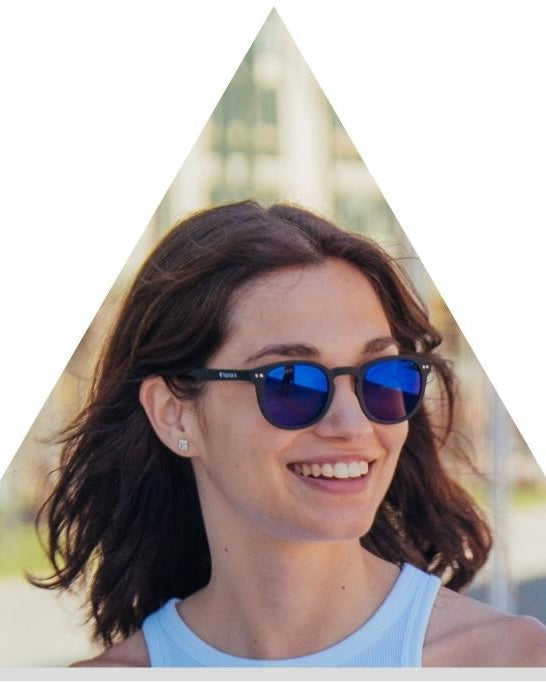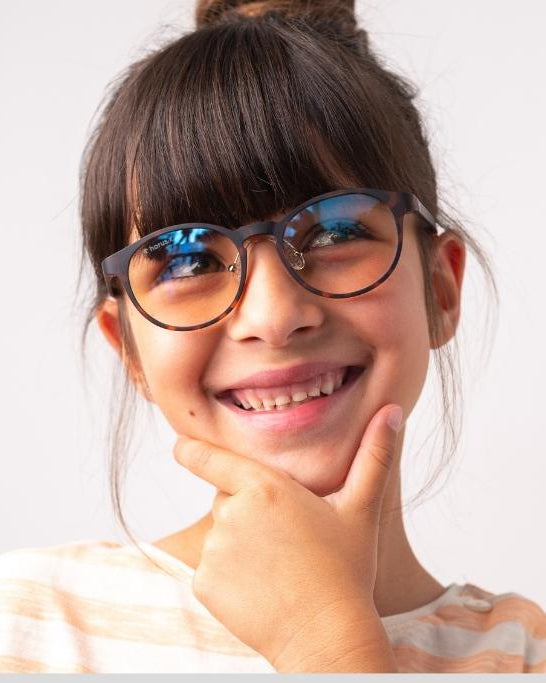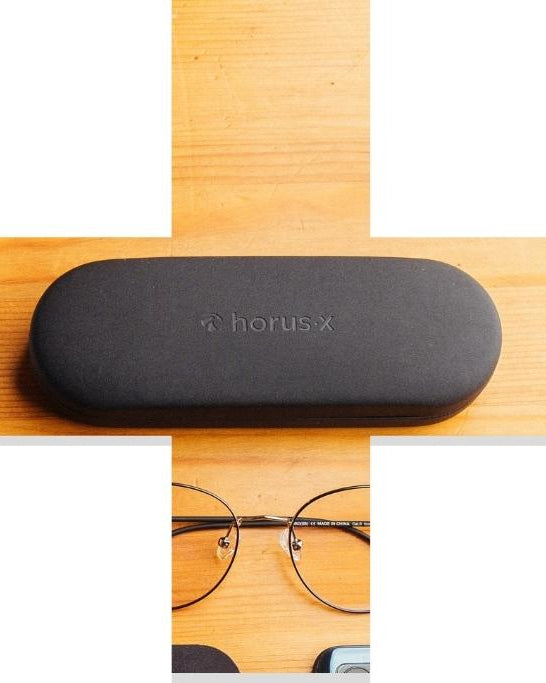Blue light: What if we were taken for pigeons? What does science say?
“The French government seems to confirm the harmfulness of blue light... While the University of Melbourne seems to affirm the opposite.”
“Is light really harmful, what does science really say?”
“Are we taken for pigeons?”
--
The Horus X team received questions as part of the filming of a program for RTBF. We took this opportunity to provide you with our answers below!
Introduction
There is a lot of talk and information about blue light. Some brands unfortunately play the stress and alarmism card .
On the contrary, we believe that it is important to be transparent and pragmatic, in order to best inform screen users about the reality of blue light in order to best optimize their well-being.
Blue light can be harmful to the retina in certain situations ( Exposure for certain sensitive populations such as children whose lens is not yet fully formed, or when using certain objects such as high intensity flashlights ).
However, in general, blue light from screens and LED lighting does not appear to be harmful to the retina of healthy adults, over short exposure .
The question of chronic (long-term) exposure is still being studied, since despite the doubts expressed by numerous scientific journals, we still lack the perspective to estimate the real risk.
The impact of blue light on sleep and circadian rhythms has been proven , which could have more significant long-term consequences when we know the correlation between quality sleep and good health, or reverses deteriorated sleep and certain pathologies. The consequences are all the more worrying as exposure to blue light from screens and lighting has become a constant component of our days.
People exposed to screens, who wish to reduce the impact of blue light on their sleep or their well-being, face a myriad of solutions, sometimes opaque regarding the quality of their filtration.
Some are ineffective because their filtration is too limited (screens that claim to limit blue light, or certain glasses with poor filtering), others filter more convincingly but this depends greatly on the brands (certain anti-blue light glasses, or software installed on certain computer or telephone screens).
Blue light filtration must nevertheless be part of a global and positive approach, which should not be a source of stress as some brands tend to communicate.
Personally, the founders are all passionate about optimizing “ well-being ”. We try to monitor many aspects of our lives and our health as best we can, we “track” our sleep and our sports activities, we monitor our diet (with particular attention to the impact of blood sugar) on our sleep and our health. .
Building an eyewear brand that takes care of our well-being and our sleep was obvious to us.
Gamers are unfortunately a particularly impacted population, with large, very bright screens, numerous LED light sources (such as lighting, mice & keyboards), particularly through intensive use over long hours, and moreover at night.
This is one of the reasons why we specialized in gaming glasses with the Horus X brand.
_____________
Question 1
- Here I have an article from the French government which confirms an effect of blue lights having a toxic effect on the retina.
- Here I have an article from the University of Melbourne which tells us that anti-blue light glasses are uselessThese are two apparently reliable sources...
So who to believe? What does science say today?
On the “phototoxicity” (harmfulness to the retina) of blue light
In communications from the French Ministry of Health, it is indeed stated that “blue light” can have a phototoxic effect on the retina. The ministry refers in particular to the report (1) of the National Agency for Food, Environmental and Occupational Health Safety (ANSES), which explains that light rich in blue can create a risk for the retina in the framework of certain exhibitions.
There are nevertheless several possible sources of blue light, that emitted by screens is not the only one studied by the ANSES report and scientific journals. It is therefore important to distinguish the intensity, the duration of exposure, and especially the origin of the blue light source, to judge whether or not it is toxic to the eye 👇
A/ Short exposure to blue light from digital screens
The intensity of the light emitted by digital screens is relatively low, so short exposure does not present a risk of harm to the eye .
B/ Short exposure to other sources of blue light
The phototoxic effect stated by the report and communications from the Ministry of Health rather concerns light devices classified in risk group 2, such as flashlights, headlamps, certain toys or automobile headlights. The risk of eye pathologies linked to exposure to these devices is increased, particularly for sensitive populations. The problem linked to these light sources is mainly correlated to the light intensity which could be too high (which therefore does not seem to be the case with screens), and which would create a risk for the retina even over relatively short exposures.
C/ Chronic/long-term exposure to blue light - all sources combined
Chronic (over several years) exposure of the retina to blue-rich light has been shown to contribute to age-related macular degeneration (AMD) (2) .
For example, Dora Adamopoulos ( Eye doctor and medical advisor to the Vision Council ), explains: “a great deal of research is currently underway to determine its precise impact on the eyes and vision. One thing is certain: the blue-violet spectrum (415-455 nm) is particularly harmful (3) . It penetrates deeply and causes photochemical reactions likely to damage retinal cells, with a cumulative effect. The retina cannot be replaced; its alteration therefore leaves the eye vulnerable to harmful light and environmental factors, thereby increasing the risk of early development of ophthalmic disorders, such as AMD" (4)
These conclusions are nevertheless based on epidemiological studies taking into account exposure to sunlight, with an intensity and characteristics very different from that of the blue light emitted by digital screens.
Even if numerous research suggests a potential risk, in the scientific literature no clear consensus has been established on phototoxicity in the context of chronic exposure to specific blue light from screens. The ANSES report also does not issue a firm opinion due to lack of perspective. “ Due to the lack of data on the chronic effects of exposure to low doses of cold light (e.g., from screens), the level of risk associated with chronic exposure to blue-rich LEDs cannot yet be evaluated to date .”
D/ Conclusion
- It appears that the light emitted by digital screens is not intense enough to cause short-term phototoxicity to the retina .
- Several studies highlight a possible link between chronic exposure to blue light and AMD , but the ANSES report and a certain number of studies are more conservative on the subject and do not take a position for the moment .
It is also important to note that beyond the phototoxic dose received, the timing of exposure plays a crucial role, with studies showing an increased vulnerability of the retina to phototoxicity during the night, due to daily rhythms. photosensitivity and retinal clock disruptions.👇
Impact of blue light from screens on our health
Beyond the specific impact of blue light from screens on the retina, it seems important to consider its consequences for our body.
Indeed, there is a proven impact of blue light from screens on circadian rhythms (5)(6) ( A circadian rhythm is a biological rhythm, lasting approximately 24 hours, such as the sleep-wake rhythm ).
The results of several experimental studies [ Chang et al. (2012) / Rahmann et al. (2017a) / Gronfier et al. (2004) / Rimmer et al. (2000) ] (7) carried out in humans, during which people were subjected to lights rich in blue from artificial lighting or screens (computers, telephones, tablets, etc.) converge and indicate that the synthesis Nocturnal melatonin (sleep hormone) is delayed or inhibited by even very low exposure to blue-rich light .
Given the sufficient evidence provided by studies carried out in humans, the disruption of circadian rhythms induced by exposure to light rich in blue in the evening or at night is considered to be proven (8) .
The impact on melatonin is directly linked to the ease of falling asleep and the quality of sleep, and is likely to have an impact on cognitive functions.
These effects have been documented for several years, with a scientific consensus now established and recognized by entities such as ANSES.
Scientific research in recent years has increasingly highlighted the importance of sleep on our health, and a short-term or chronic impact can have effects on our well-being, or on the contrary on our health ( a lack of sleep being linked to an increased risk of insulin resistance (9) , diabetes, neurodegenerative diseases such as Alzheimer's (10)(11) , etc.).
(The link between sleep problems and increased health risks is proven, but today there is no demonstrated effect between digital blue light and the risks cited above.)
However, circadian rhythms and sleep are among the most important mechanisms for our body and our health, so this negative impact of blue light from screens on our sleep is important and concerning .
It is with this in mind that we place ourselves, in order to allow the greatest number of screen users, gamers and professionals alike, to filter the blue light from their screens as much as possible in order to reduce the potential negative effects.
On the other hand, it also seems important to us not to fall into gross alarmism. Some brands do not hesitate to bring out the risk card of “ severe depression, bipolar disorders, anxiety and, in the most serious cases, post-traumatic stress syndrome ”. This discourse is not completely unfounded, but it is often exaggerated and stressful, not to mention that it will tend to discredit the discourse around blue light.
The subject is serious, and there is a potentially significant impact on our well-being, but we should not be afraid of screens either. A not unreasonable exposure of a few minutes per day, even in the evening, will not cause considerable risks to our health.
Blue light filtration is a gesture to consider to improve our well-being, in the long term, and this is part of a general approach to reducing screen use, reducing stress, good nutrition & hydration, as well as attention to optimizing our sleep and our health.
_____________
Question 2We talked about different solutions to protect our eyes from screens and blue lights. Do they seem effective to you? Or are we taken for fools?
- Screen solutions
- Softwares
- Glasses
On market solutions (and their study), to filter blue light.
Certain studies, such as that of Melbourne but also the ANSES report, highlight a large disparity in effectiveness between the different means of filtering blue light (particularly concerning glasses).
It is important to note that according to the ANSES report:
- No effectiveness has been demonstrated on screens that claim to limit blue light emission.
- Reducing the color temperature (warm white) and brightness of the screens showed some reduction in the amount of blue light emitted (example: F.lux software)
- Regarding the filtration of “treated lenses”, there are very big differences in efficiency between optician lenses and lenses designed specifically to filter blue light from screens, as well as between different brands. Specific glasses against blue light generally have greater filtering efficiency than treated ophthalmic lenses: “ These yellow-orange glasses filter between 28% and 59% (depending on the models tested) of the phototoxic blue radiation emitted by lighting and LED screens, compared to 7% to 12% for treated ophthalmic lenses)" .
> For comparison, our amber glass (patented Plasma ® Technology) filters more than 83% on the 380-500nm spectrum.
Some scientific studies, including that of Melbourne, indicate:
- Not having observed a positive effect on the retina ( which is already identified in the literature since the risk of harm is low or even zero )
- Not being able to conclude on a potential effect of anti-blue light glasses on sleep quality. This is not an opinion opposed to this observation, but an opinion which states that it does not have enough elements to conclude that there is a positive link.
>> Note also that the disparity between the filtrations of the glasses tested strongly impacts the results. “ Potential effects on sleep quality were also indeterminate, with included trials reporting mixed outcomes among heterogeneous study populations (...) It's also worth bearing in mind that blue-light filtering lenses typically filter out about 10-25% of blue light, depending on the specific product. Filtering out higher levels of blue light would require the lenses to have an obvious amber tint, which would have a substantial effect on color perception (12) ” - In conclusion, the study essentially states that the studies are still undecided on the positive effect or not of lenses treated against blue light, and that anti-light glasses have very different filtration characteristics from one model to another. .
- Other studies highlight the positive effects of certain anti-blue light glasses. “ However, there have been some previous clinical studies that demonstrate that BB spectacle lenses can reduce the symptoms of eye strain in individuals who use digital devices (Ide et al. , 2015; Lin et al., 2017). BB lenses may also improve sleep quality if the user wears them at night (Lawrenson et al., 2017; Esaki et al., 2020) (13) . ”
- Moreover, according to ANSES “ wearing filter glasses increases the quality and quantity of sleep, and the concentration of melatonin (14) ”
In conclusion, anti-blue light glasses from opticians often offer far too limited effectiveness, and the lenses specifically treated by brands of anti-blue light glasses are not all at the same level of filtration.
It is important to note that the glasses tested in these studies often seem to have too low filtration to provide a significant effect, therefore leading to logical conclusions on this typology of products in certain studies!
This is also a regulatory problem, since no standard specifically governs the minimum filtration rates that glasses should offer in this context of use. Each brand (of which we are a part) is therefore free to treat its lenses as it wishes, particularly for glasses without prescription.
This is one of the problems that we identified when we decided to create our own brand in 2017: market players often have filtration systems that are far too weak to have a real impact.
It is on this point that our products stand out, since we provide higher patented filtration than other players on the market (laboratory tests to support).
In general, we recommend using several means of filtering blue light.
🫶 Processing by software like F.lux is a good, easy and effective compromise for reducing the intensity of light on your computer screen, and changing the colorimetry of the screen towards yellow/orange (Our team has also installed this software).
However, this solution is sometimes limited, as wearing glasses is complementary. Wearing glasses will:
- To filter all light sources, such as the TV which generally does not have a software filter.
- Ambient lighting ( almost always LED today )
- Other LED light sources such as mice or keyboards are often backlit for gamers.
_____________
QUESTION 3
We see that it is possible to put an anti-blue light treatment on prescription glasses, which we would wear all the time. Isn't it risky to block blue light, even natural light?
Light is in fact an essential element in calibrating our circadian rhythms. Natural blue light from the sun is crucial first thing in the morning to allow our bodies to be fully awake and alert.
🌞It is regularly recommended (15) to expose yourself to sunlight as soon as you wake up, in particular to suppress the production of melatonin and increase the level of cortisol ( important when waking up despite the association that we regularly make with the stress ).
Exposure to the sun from the first hours of waking up improves mood and cognitive functions, but also improves falling asleep at the end of the day thanks to better calibration of melatonin production in the evening ( unless we expose ourselves to sunlight). blue light in the evening as seen above ).
So in fact, with filtration of blue light in the first hours of the day we eliminate the positive effect of exposure to sunlight, particularly via blue light. It is therefore important not to filter this light!
However, as mentioned previously, the anti-blue light treatment of prescription glasses is generally not very filtering, therefore not having a real negative impact in the morning (nor really positive in the evening since there is also little filtering)
_____________
QUESTION 4
Here's a video that shows us that some glasses don't really block blue light. How do we know which ones really work?
It's hard to know which glasses really block blue light. Generally speaking, several clues make it possible to identify that the glass is treated against blue light:
- The presence of a bluish reflection on the glasses.
Anti-reflection is generally not a sign that the glass is treated in its very design since it is a surface treatment, but it is a first clue. In general, optician lenses are only treated on the surface against blue light (hence a certain lack of effectiveness) - The presence of a more or less pronounced coloring of the glass, ranging from gray to red through yellow or orange colors. The tint of the glass depends greatly on the brands and their treatment, but generally speaking, the darker the glass, the more light it filters and therefore the more likely it is to have high filtration. However, depending on the processing technologies and brands, there may be a notable difference between two apparently equivalent shades.
The best way to know the actual filtration of a lens is to ask the manufacturer for the filtration rates on the different blue light spectrums. A serious brand will have carried out the tests to answer the question, other brands will not necessarily want to communicate on these figures, which can say a little more about the seriousness of their product.
Regarding the video, it is difficult to really position yourself, but we can note:
- As we have seen previously, the anti-blue light filters of prescription glasses are often surface coatings with very limited overall effectiveness.
- The little gadget with a pen and a card is not a good guarantee of quality. Generally sold alongside certain low-end products, these pens actually generally emit light close to the UV spectrum. Most glasses on the market today are 100% anti-UV, so this test does not provide much information.
- The video is very incomplete, and the conclusions are hasty and easy, such as explaining that “it doesn't work” when we see that the 450nm peak is not reduced. The speech lacks nuance and explanations (normal with the TikTok format…). There is indeed a peak of light emitted at 450nm for LED light, but we could, for example, debate whether it is the most harmful. Declaring that it is effective would still require qualifying on what criteria.
Blue light from LEDs is made up of several spectra, each having a useful or worrying component, according to different types of criteria ( exposure duration, light intensity, time of exposure during the day ): - Exposure to the 380-400nm spectrum , which this telescope undoubtedly filters 100%, does not have the same problem ( potential (?) long-term impact linked to a more energetic light intensity on this spectrum with short waves ) ...
- ....that exposure to light around 450nm ( peak blue LED light, less energetic but in greater quantity )...
- ...or even exposure to the 450-500nm spectrum ( linked to the production of melatonin, and therefore exposure to be avoided in the evening but important at the start of the day ).
- This is just one example, but it still shows that the discourse on blue light is often reductive and not always based on serious arguments.
QUESTION 5
If you had to give us some advice to protect our eyes, what would it be?
Attention for children and adults up to 25 years old?
Aren't all these filters masking the problem which is that we use screens too much and sometimes at the wrong times?
Paradoxically at Horus
We devote a lot of time to research on the subject, and we have also published a file on recommended screen time by age: suffice to say that the average is far from being respected! And we understand why.
Screens are addictive in themselves, and an army of engineers are designing ever more powerful algorithms to make us even more addicted. In short, we have almost no chance of reducing our screen consumption if we do not put serious safeguards in place.
In the team, for example, some members use the “ Digital Well-being ” application on Android, in order to limit the time spent on certain applications (like Instagram for example).
We must also be realistic, because today it is difficult to completely ban screens from our lives. Here are our recommendations:
- No screens before age 3 (impact on cognitive development)
- 1 hour per day up to 6 years old,
- 1 to 2 hours per day up to 12 years old, with parental supervision
- 2 to 4 hours per day for adolescents
For adults and seniors, it is recommended to reduce exposure to reasonable limits.
Prioritizing reading after a certain time can be a good practice = Aiming for at least 1 hour without a screen before going to bed seems to us to be a good goal (this also applies to the phone!).
In addition, we recommend reducing the light intensity at home, by dimming the atmosphere a little more and avoiding intense lights, especially those that are very white or bluish ( favoring orange lights ).
Furthermore, even if we did not really mention it earlier, one of the problems linked to screens is the fact of staring at a fixed object close to the face for long minutes or long hours, particularly for people working all day on computer. In this context, well-being also involves disconnecting from screens when possible.
Our recommendations :
- Favor phone calls over video conferences, and take the opportunity to chat while walking. This allows the body to be active, while being more efficient cognitively. It also allows you to rest your eyes.
- When working on a screen for long periods of time, follow the 20/20/20 rule . This consists of turning your eyes towards an object located 20 feet (or 6 meters) away for at least 20 seconds, every 20 minutes, thus reducing visual fatigue.
And in any case, wearing anti-blue light glasses is a plus, especially in the evening, because regardless of whether you use a screen or not, there is a good chance that you spend time lit by LEDs.
Stéphane GUYOT
Co-founder Horus
References
- Effects on human health and the environment (fauna and flora) of light-emitting diodes (LED) ANSES opinion Collective expert reports April 2019 - Scientific edition
- ibid.
- Arnault, E., Barrau, C. et al. Phototoxic action spectrum on a retinal pigment epithelium model of Age-related Macular Degeneration exposed to sunlight normalized conditions. PlosOne, 2013; 8(8), http://journals.plos.org/plosone/article?id=10.1371/journal.pone.0071398
- Points of View - International Review of Ophthalmic Optics Special Edition - Collection of articles from 2011 to 2015
- Brainard GC, Hanifin JP, Greeson JM, Byrne B, Glickman G, Gerner E, Rollag MD [2001]. Action spectrum for melatonin regulation in humans: evidence for a novel circadian photoreceptor. J Neurosci 21(16):6405–6412.
- Thapan K, Arendt J, Skene DJ [2001]. An action spectrum for melatonin suppression: evidence for a novel non-rod, non-cone photoreceptor system in humans. J Physiol 535(Pt 1):261-267.
-
> Chang, Anne-Marie, Nayantara Santhi, Melissa St Hilaire, Claude Gronfier, Dayna S. Bradstreet, Jeanne F. Duffy, Steven W. Lockley, Richard E. Kronauer, and Charles A. Czeisler. 2012. “Human Responses to Bright Light of Different Durations.” The Journal of Physiology 590 (13): 3103-12. https://doi.org/10.1113/jphysiol.2011.226555.
> Rahman, Shadab A., Melissa A. St Hilaire, Anne-Marie Chang, Nayantara Santhi, Jeanne F. Duffy, Richard E. Kronauer, Charles A. Czeisler, Steven W. Lockley, and Elizabeth B. Klerman. 2017. “Circadian Phase Resetting by a Single Short-Duration Light Exposure.” JCI Insight 2 (7): e89494. https://doi.org/10.1172/jci.insight.89494
> Gronfier, Claude, Kenneth P. Wright, Richard E. Kronauer, Megan E. Jewett, and Charles A. Czeisler. 2004. “Efficacy of a Single Sequence of Intermittent Bright Light Pulses for Delaying Circadian Phase in Humans.” American Journal of Physiology. Endocrinology and Metabolism 287 (1): E174-181. https://doi.org/10.1152/ajpendo.00385.2003
> Rimmer, DW, DB Boivin, TL Shanahan, RE Kronauer, JF Duffy, and CA Czeisler. 2000. “Dynamic Resetting of the Human Circadian Pacemaker by Intermittent Bright Light.” American Journal of Physiology. Regulatory, Integrative and Comparative Physiology 279 (5): R1574-1579. https://doi.org/10.1152/ajpregu.2000.279.5.R1574 - Effects on human health and the environment (fauna and flora) of light-emitting diodes (LED) - ANSES opinion (Collective expert reports April 2019 - Scientific edition): Page 8 / 27
- https://pubmed.ncbi.nlm.nih.gov/35189549/
- https://www.nih.gov/news-events/nih-research-matters/lack-sleep-middle-age-may-increase-dementia-risk
- https://pubmed.ncbi.nlm.nih.gov/25188896/
- https://www.cochrane.org/news/blue-light-filtering-spectacles-probably-make-no-difference-eye-strain-eye-health-or-sleep
- Lian Y, Lu W, Huang H, Wu G, Xu A and Jin W (2022) The Long-Term Effect of Blue-Light Blocking Spectacle Lenses on Adults' Contrast Perception. Forehead. Neuroscience. 16:898489. doi: 10.3389/fnins.2022.898489
- Effects on human health and the environment (fauna and flora) of light-emitting diodes (LED) - ANSES opinion (Collective expert reports April 2019 - Scientific edition): page 85 / 424
- https://archive.cdc.gov/#/details?url=https://www.cdc.gov/niosh/emres/longhourstraining/light.html








































